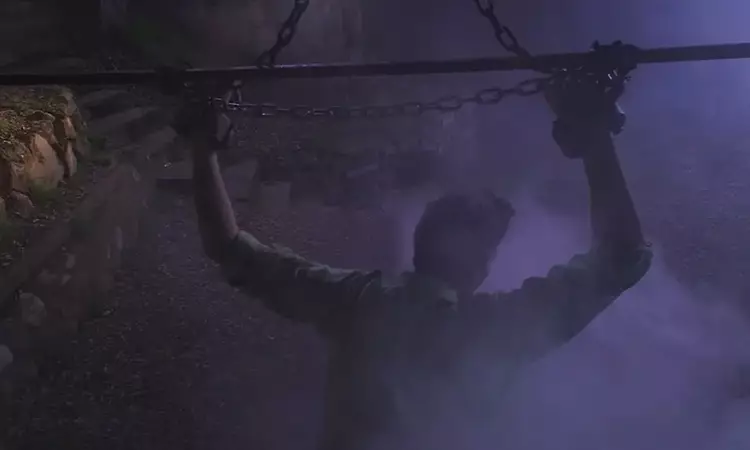The opening moment of *Cursed in Baja* strikes a somber tone as the prison guard, portrayed by Hugo Armstrong, leads inmate Pirelli, played by Jeff Daniel Phillips, towards what is presumed to be his final moments before execution. However, this sequence unfolds not as a predictable descent into darkness, but rather as an introduction to a story steeped in complexity, where time is anything but linear. From the outset, the film establishes a tone of uncertainty, revealing that the protagonist is on the verge of liberation, but liberation in a world where the past cannot simply be shaken off.
In the initial scenes, the viewer is treated to a montage of disjointed memories. A motorbike ride through the barren desert evokes both freedom and entrapment, illustrating Pirelli’s struggle to escape his own haunting past. Interspersed with Pirelli’s memories are striking visions of Helen Kemper, a character whose indifference towards her son Quinn showcases the fractured relationships that lie at the heart of Pirelli’s journey. This non-linear structure mirrors Pirelli’s internal chaos, creating an atmosphere where past decisions and present reality intertwine, revealing the cyclical nature of trauma.
Pirelli’s struggle echoes the sentiments of countless individuals battling their inner demons upon re-entering society. The parole officer, Jill Garvey (Barbara Crampton), serves as a narrative anchor, thrusting a stark warning upon Pirelli about the true dangers that lurk outside prison walls. This warning resonates deeply not only within the confines of the film but reflects the reality of many ex-convicts who face the formidable task of grappling with their histories as they attempt to carve a new existence.
The film employs psychological depth to explore its protagonist. Once an Iraq war veteran and LAPD detective, Pirelli’s past traumas have led him down a tumultuous path of addiction and despair. Director and writer Jeff Daniel Phillips navigates through Pirelli’s dual nature of seeking redemption while being constantly haunted by the shadows of his previous life. The cyclical structure of Pirelli’s journey back to Baja to find the missing Quinn is a poignant narrative device that elaborates on the idea of cyclical mistakes and the inescapability of one’s past.
Returning to Baja, the site of his former failures, Pirelli is thrust once more into a quagmire of danger and regret. The film juxtaposes his previous case concerning Helen Kemper’s abduction against his current mission, amplifying the poignant sense of déjà vu. This doubling of narratives emphasizes the struggles of not just Pirelli but also the families embroiled in the chaos of crime and loss. Robert Kemper, portrayed by Jim Storm, introduces an emotional weight, as he seeks a resolution for his missing grandson, reminiscent of past attempts to find his daughter.
As Pirelli grapples with his crumbling medication regimen and the resurgence of traumatic memories, his determination to solve the case reveals a nuanced reflection on the nature of human resilience. He must navigate through a kaleidoscope of bizarre characters and criminal influences that lurk in the shadows. The introduction of local gangsters, double-crossing lovers, and cultic elements rooted in surrealism populate a landscape that emphasizes both the absurdity and gravity of his investigation.
Adding to the film’s elaborate tapestry is the chilling presence of the mythical chupacabra, a manifestation of the lurking evils within society and, allegorically, within Pirelli himself. Instead of merely serving as a terrifying creature in folklore, the chupacabra is a vehicle through which we explore the darker impulses present within humanity. Through Pirelli’s unreliable narration, the creature becomes a symbolic beast that illustrates the depths to which characters are willing to sink, echoing themes of sacrifice and the destruction brought forth under the influence of greed and drugs.
While the chaotic narrative encompasses a form of horror and surrealism, it underscores Pirelli’s struggle with mortality and morality. Ultimately, this fantastical creature serves not just as a plot device but as an embodiment of the protagonist’s most primal fears—the fear of succumbing to the monstrous impulses that lie dormant within every human being.
As the film draws to a close, the poetic resonance of Pirelli’s journey becomes apparent. Despite all efforts of self-improvement and redemption, he finds himself ensnared within the same traps of crime and despair from which he sought to escape. The notion of being “cursed,” shared with the Kemper family, implicates not merely a single individual but a lineage caught in the relentless repetition of trauma.
*Cursed in Baja* presents a chilling examination of how the past, present, and future are inexorably intertwined. The film delves into the psychological torment of a man attempting to reclaim his life while battling the burdens of his history, reinforcing that sometimes, true freedom may prove more elusive than anticipated. Through masterful storytelling and complex character arcs, it challenges audiences to confront the darker facets of human experience, illustrating that we might be destined to repeat our stories, no matter how fervently we wish to escape them.

